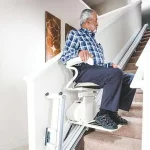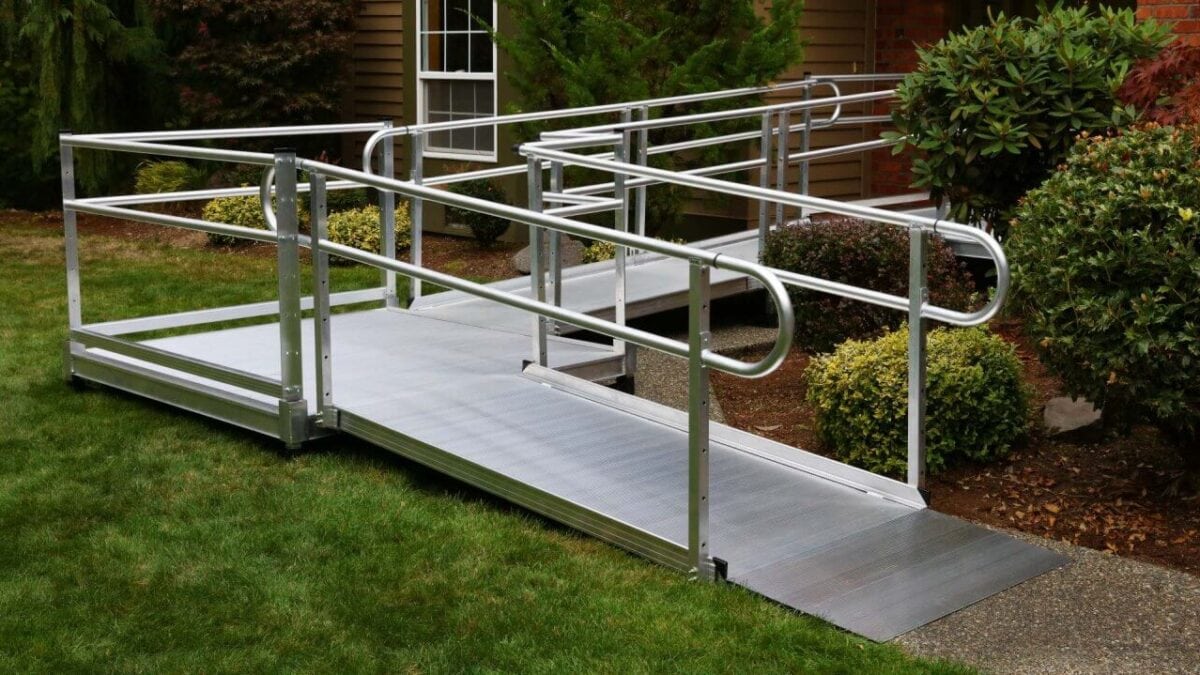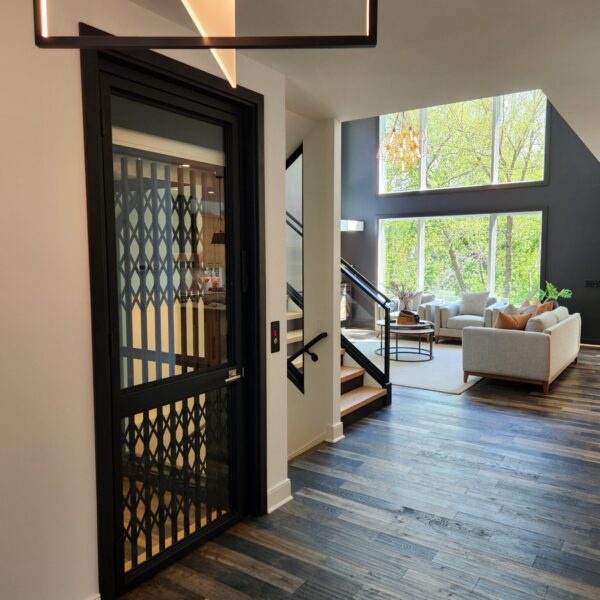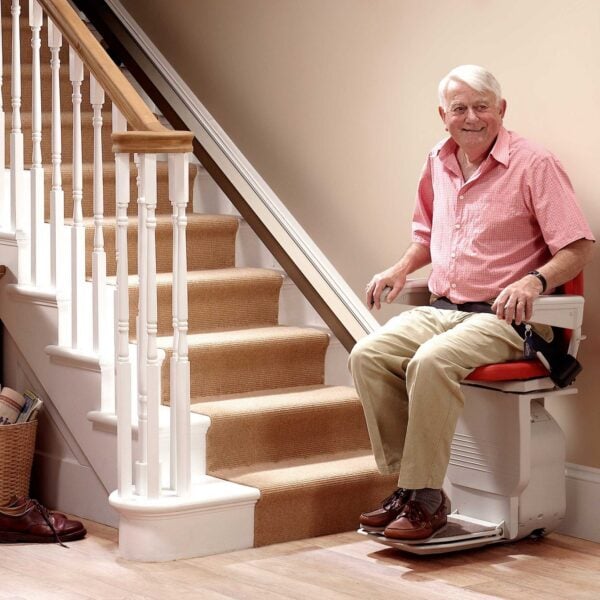
Accessibility in the Home
November 19, 2024
Creative Design Ideas for Aesthetic and Accessible Wheelchair Ramps
December 3, 2024As a homeowner or caregiver, one of the most crucial decisions you’ll make is selecting the right material for a wheelchair ramp. This choice not only provides essential accessibility but also ensures safety, durability, and functionality for the user. Among the most common materials used are wood, aluminum, and concrete. Each material has its advantages and drawbacks, making the choice highly dependent on factors like your budget, environment, and aesthetic preferences. In this guide, we’ll explore the pros and cons of these three popular materials to help you make an informed decision.
Wood: Timeless and Versatile
Wooden wheelchair ramps are a classic choice, offering both functionality and a wide range of design possibilities. They can be customized to fit any home’s style, from rustic to modern, making them a favorite among homeowners who prioritize design.
Advantages of Wood:
- Aesthetic Appeal: Wood has a natural, warm look that blends well with most home exteriors. You can paint or stain it to match your home’s color scheme.
- Customizability: Wooden ramps can be easily tailored to fit unique spaces or specific design requirements.
- Cost-Effective: In many cases, wood is a budget-friendly option compared to other materials, especially for shorter ramps.
Disadvantages of Wood:
- Maintenance: Wood is susceptible to weather-related damage, such as rotting, warping, and splintering. Regular maintenance, including sealing and painting, is necessary.
- Durability: While wood can last for years with proper care, it’s not as long-lasting as concrete or aluminum.
- Traction: Wooden ramps can become slippery when wet, requiring additional non-slip treatments or coatings.
Wooden ramps are ideal for those who value aesthetics and are willing to invest time in maintenance. They’re also an excellent option for temporary or semi-permanent ramps.
Aluminum: Lightweight and Durable
Aluminum ramps are a modern and convenient option. Known for their lightweight design and corrosion resistance, aluminum ramps are an excellent choice for both temporary and permanent installations.
Advantages of Aluminum:
- Durability: Aluminum is resistant to rust, corrosion, and weather damage, making it a low-maintenance option.
- Portability: Many aluminum ramps are modular, meaning they can be easily disassembled, moved, and reassembled. This is particularly beneficial for renters or those who might relocate.
- Traction: Aluminum ramps often come with built-in non-slip surfaces, ensuring safety in all weather conditions.
- Quick Installation: Prefabricated aluminum ramps can be installed quickly, saving time and labor costs.
Disadvantages of Aluminum:
- Cost: Aluminum ramps can be more expensive upfront compared to wood.
- Aesthetic Limitations: While functional, aluminum ramps may not blend seamlessly with all home designs. They have a more industrial appearance.
- Heat Retention: In hot climates, aluminum ramps can become uncomfortably warm to the touch.
Aluminum ramps are the ideal choice for individuals seeking a durable, low-maintenance, and portable solution. Their practicality makes them handy for temporary needs or outdoor installations, providing a versatile solution for a variety of situations.
Concrete: Strong and Permanent
Concrete ramps are a durable and permanent solution, often chosen for their strength and stability. These ramps are standard in both residential and commercial settings.
Advantages of Concrete:
- Durability: Concrete ramps are extreme and can withstand heavy usage and extreme weather conditions for decades.
- Low Maintenance: Once installed, concrete requires little to no maintenance aside from occasional cleaning.
- Customizable Design: Concrete can be molded into various shapes and designs, and decorative finishes can be applied for a more polished look.
- Safety Features: Concrete ramps can be textured to provide excellent traction, reducing the risk of slips and falls.
Disadvantages of Concrete:
- Cost: The initial cost of a concrete ramp, including labor and materials, is typically higher than wood or aluminum.
- Permanent Installation: Concrete ramps are not portable, making them unsuitable for temporary needs or renters.
- Time-Intensive: Installation involves curing time, which can delay usability compared to prefabricated ramps.
- Appearance: While customizable, concrete’s aesthetic appeal is often less versatile compared to wood.
Concrete ramps are best suited for homeowners seeking a permanent, long-lasting solution. They’re particularly advantageous for high-traffic areas or homes in regions with extreme weather conditions.
Comparing the Materials: Key Factors to Consider
When choosing between wood, aluminum, and concrete, it’s essential to evaluate your specific needs. Here are some factors to help guide your decision:
- Budget:
- Wood: Generally, it is the most affordable option upfront.
- Aluminum: Moderately priced but offers savings in long-term maintenance.
- Concrete: Higher initial cost but highly durable.
- Durability:
- Wood: Moderate, with regular upkeep.
- Aluminum: Highly durable with minimal maintenance.
- Concrete: Extremely durable and long-lasting.
- Aesthetic Appeal:
- Wood: Versatile and attractive, ideal for blending with home design.
- Aluminum: Functional and modern but less customizable.
- Concrete: Functional with limited aesthetic flexibility.
- Ease of Installation:
- Wood: Requires skilled labor and some time for construction.
- Aluminum: Quick and easy, especially with prefabricated models.
- Concrete: Labor-intensive and requires curing time.
- Environmental Considerations:
- Wood: Can be eco-friendly if sourced from sustainable materials.
- Aluminum: Recyclable and environmentally friendly.
- Concrete: High carbon footprint during production.
Selecting the right material for your wheelchair ramp depends on balancing your priorities, including budget, durability, aesthetics, and maintenance requirements. Wooden ramps offer timeless appeal and customizability but demand regular upkeep. Aluminum ramps are lightweight, portable, and low maintenance, making them a practical choice for many households. Concrete ramps, while more expensive and permanent, provide unmatched durability and strength.
By understanding the advantages and disadvantages of each material, you can make an informed choice that ensures accessibility, safety, and satisfaction for years to come. Whether you opt for wood, aluminum, or concrete, investing in a quality wheelchair ramp is a step toward creating a more inclusive and functional home.
CAPS Remodeling is here to help you weigh your choices and design a ramp that fits your budget, style, and accessibility requirements. Contact us today for expert guidance and professional wheelchair ramp installation services that ensure your ramp is both functional and beautiful!

Introducing Jeff Cates, the visionary Founder and Owner of CAPS Remodeling. After experiencing a profound personal event involving his son in 2007, Jeff was inspired to serve a higher purpose: to create safer, more comfortable, and independent living conditions for the elderly and disabled by modifying their current homes. Jeff’s deep-seated religious beliefs form the moral compass that steers CAPS daily operations. Apart from his unwavering dedication to his work, Jeff finds joy in boating and cherishing moments with his family.




